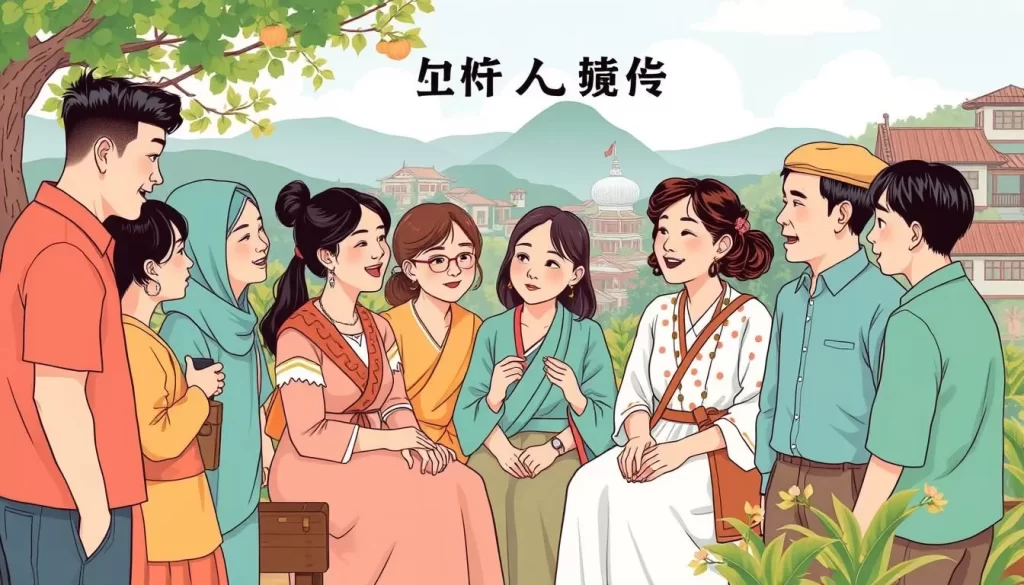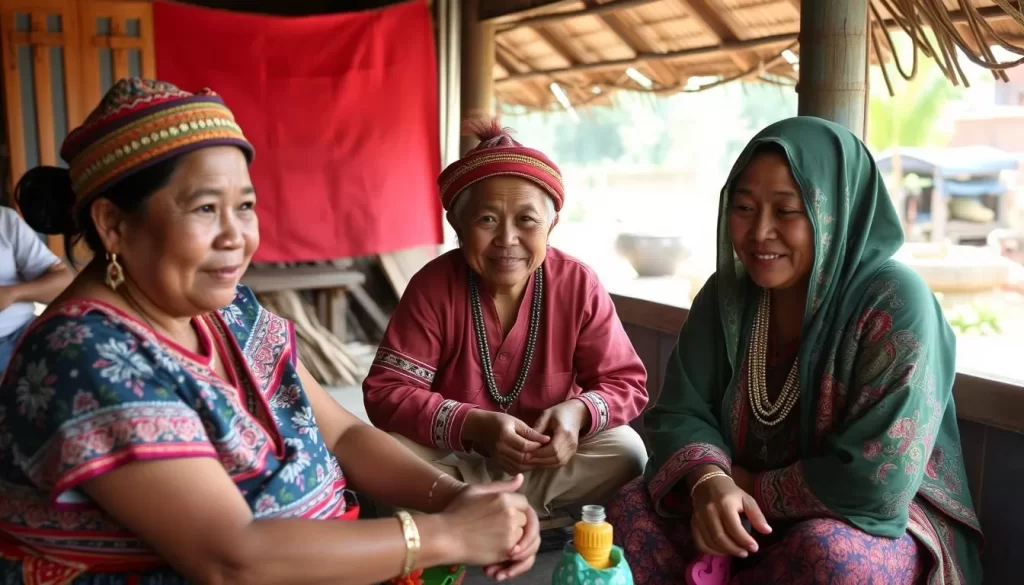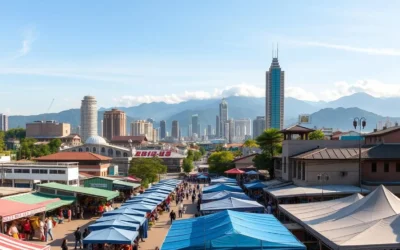✓ Accommodations ✓ Flights ✓ Rental Cars
You’re about to explore a region that boasts a rich cultural heritage and a complex history, reflected in its diverse linguistic landscape. Located in southwestern Taiwan, Chiayi County is a fascinating example of how language and culture intertwine.
The official language of Taiwan is Mandarin Chinese, but Chiayi County’s linguistic makeup is more nuanced. Shaped by waves of migration, colonial influences, and indigenous populations, the languages spoken here are a testament to its unique identity. As you delve into this guide, you’ll gain insights into the historical development of languages in Taiwan and the current language policies that affect communication in this vibrant region.
The Linguistic Landscape of Chiayi County
You can observe a complex interplay of languages in Chiayi County, influenced by its geography, history, and the people who inhabit the region. The county’s linguistic diversity is a result of its unique geographic setting and the various populations that have settled there over time.
Geographic and Demographic Overview
Chiayi County is situated in southwestern Taiwan, bordered by Yunlin County to the north, Tainan City to the south, the Taiwan Strait to the west, and the Central Mountain Range to the east. This diverse geography has significantly influenced the distribution of languages in the region. The county’s population consists primarily of Hoklo people, who speak Taiwanese Hokkien, with significant Hakka communities and smaller indigenous populations, particularly in the eastern mountainous regions.
| Geographic Feature | Impact on Language |
|---|---|
| Central Mountain Range to the east | Influences language distribution and isolation |
| Taiwan Strait to the west | Facilitates cultural and linguistic exchange |
| Bordered by Yunlin County and Tainan City | Contributes to linguistic diversity through regional interactions |
Historical Language Development in the Region
The linguistic landscape of Chiayi County has been shaped by multiple waves of migration and historical events. Initially, the region was inhabited by indigenous Formosan language speakers. The arrival of Han Chinese immigrants from Fujian province brought Hokkien dialects that eventually developed into Taiwanese Hokkien. The Dutch colonial period and Japanese colonial era also left significant marks on the linguistic development of the region, introducing new languages and suppressing local ones. Today, Chiayi County reflects Taiwan’s broader pattern of colonization, migration, and cultural exchange, making it a fascinating case study in language development and preservation.

Mandarin Chinese: The Official Language
As you explore Chiayi County, you’ll notice that Mandarin Chinese plays a vital role as the official language. It’s the primary means of communication in government administration, education, and formal settings.
Status and Usage in Chiayi County
Mandarin Chinese is widely spoken and understood by virtually all residents of Chiayi County, regardless of their ethnic background or mother tongue. In schools, Mandarin is the primary language of instruction, although efforts have been made to incorporate local language education into the curriculum. This widespread use of Mandarin has established it as a lingua franca among the various groups in Taiwan, including the Taiwanese-speaking Hoklo, Hakka, aboriginals, and Mainland Chinese.
- Mandarin Chinese serves as the official language throughout Taiwan, including Chiayi County.
- You’ll find that virtually all residents can speak Mandarin and understand it, regardless of their background.
- In Chiayi’s schools, education is primarily conducted in Mandarin.

Taiwanese Mandarin Characteristics
The Taiwanese Mandarin spoken in Chiayi County has distinctive characteristics that differentiate it from the Mandarin spoken in mainland China. These include unique vocabulary, pronunciation patterns, and grammatical structures. The Mandarin spoken in Chiayi often features influences from Taiwanese Hokkien, particularly in casual conversation, creating a localized variant with distinctive tonal patterns and vocabulary.
Many Chiayi residents code-switch between Mandarin and Taiwanese Hokkien, sometimes within the same conversation or even sentence, depending on the context and audience. While younger generations tend to be more proficient in Mandarin, there remains a strong connection to the linguistic heritage of the region.
Taiwanese Hokkien: The Heart of Chiayi County

As you explore Chiayi County, you’ll discover that Taiwanese Hokkien is more than just a language – it’s the heartbeat of the community. Taiwanese Hokkien, also known as Taiwanese or Tâi-gí, is the most-spoken native language in Taiwan, with about 70% of the population using it.
Prevalence and Importance in Southern Taiwan
Taiwanese Hokkien remains the primary language of daily communication for many residents in Chiayi County, especially in rural areas and traditional markets. You’ll find that Chiayi County has one of the highest percentages of Taiwanese Hokkien speakers in Taiwan, with the language deeply embedded in local culture and identity.
Southern Taiwan, including Chiayi County, is considered the stronghold of Taiwanese Hokkien, where it has maintained greater vitality compared to northern urban centers.
Chiayi County’s Distinctive Hokkien Features
The Hokkien spoken in Chiayi County has distinctive characteristics that set it apart from other varieties spoken in Taiwan. These include unique vocabulary, pronunciation patterns, and expressions that reflect the region’s agricultural heritage. The Taiwanese Hokkien accent in Chiayi County falls between the Hái-kháu and Lāi-po͘ accents, influenced by both Quanzhou and Zhangzhou dialects.
Generational Differences in Hokkien Usage
You’ll notice significant generational differences in Hokkien usage within Chiayi County. Older residents are typically more fluent and use it as their primary language, while younger generations may have varying levels of proficiency. Middle-aged residents often serve as linguistic bridges, code-switching between Hokkien and Mandarin.
Despite efforts to promote Taiwanese Hokkien, the language faces challenges in transmission to younger generations. However, Chiayi County maintains stronger intergenerational language transfer than many other regions.
Hakka Language Communities in Chiayi
As you explore the linguistic diversity of Chiayi County, you’ll discover the significant presence of Hakka language communities. While Hakka is predominantly spoken in other parts of Taiwan, such as Taoyuan, Hsinchu, and Miaoli, Chiayi County is home to a notable Hakka-speaking population.

Distribution and Demographics
The Hakka language in Chiayi County is primarily represented by the Sixian and Hailu subdialects, reflecting the ancestral origins of Hakka migrants who settled in the region. You can find significant Hakka-speaking populations in specific townships and villages throughout the county, creating distinct cultural enclaves within the predominantly Hokkien-speaking environment.
These communities have maintained their linguistic heritage despite being surrounded by other language groups, showcasing the resilience of the Hakka language and culture.
Cultural Significance and Preservation
The Hakka language carries significant cultural importance for its speakers in Chiayi, serving as a marker of identity and a vehicle for transmitting traditional values, customs, and knowledge across generations. To preserve this linguistic heritage, local cultural festivals, language classes, and community initiatives have been established to encourage younger generations to learn and use the Hakka language.
The government has also played a crucial role in supporting Hakka language preservation through agencies like the Hakka Affairs Council, which runs Hakka TV and Radio stations. Many Hakka speakers in Chiayi are multilingual, fluent in Hakka, Taiwanese Hokkien, and Mandarin, allowing them to navigate different social contexts while maintaining their linguistic heritage.
Efforts to preserve the Hakka language are not limited to government initiatives. Community-driven projects and cultural events have been instrumental in keeping the language alive and vibrant, ensuring its continuation for future generations.
Indigenous Formosan Languages in the Region

As you explore the linguistic landscape of Chiayi County, you’ll discover the significant presence of indigenous Formosan languages. These languages are part of the broader Austronesian language family, which has spread throughout the Pacific. The historical presence of indigenous languages in Chiayi County dates back thousands of years, predating the arrival of Han Chinese settlers by millennia.
Historical Presence of Indigenous Groups
Chiayi County has historically been home to several indigenous groups, primarily from the Tsou and Bunun peoples. Their traditional territories extended into what is now the eastern mountainous regions of the county. The indigenous Formosan languages spoken in the Chiayi region belong to the Tsouic and Southern Formosan language families, representing some of the oldest linguistic heritage on the island.
Current Status and Revitalization Efforts
Over the years, indigenous languages in Chiayi County have faced severe challenges due to colonization, assimilation policies, and demographic changes, leading to language shift and endangerment. However, current revitalization efforts for indigenous languages in Chiayi include community-based language nests, school programs, and cultural activities supported by both indigenous communities and government initiatives. The Council of Indigenous Peoples has established standardized writing systems for Formosan languages and provides resources for language documentation and education in Chiayi County.
The recognition of Formosan languages as national languages of Taiwan in 2017 has provided additional support and legitimacy to revitalization efforts in Chiayi County and throughout Taiwan. While the number of fluent speakers of indigenous languages in Chiayi is relatively small, there’s growing interest among younger indigenous people in reconnecting with their linguistic heritage.
Japanese Language Influence in Chiayi County
You’ll find that the Japanese language has had a profound influence on the way people communicate in Chiayi County. This influence is a result of the significant historical period when Taiwan was under Japanese rule from 1895 to 1945. During this time, Japanese became the official language of government, education, and public life, leaving a lasting legacy in the region.
Colonial Legacy on Local Dialects
The colonial era had a profound impact on the local dialects in Chiayi County. The influence is evident in pronunciation patterns, intonation, and certain grammatical structures that show Japanese characteristics, particularly in the speech of older generations who received Japanese education. This legacy is a testament to the region’s history and cultural exchange.
As a result of this historical period, the local dialects have incorporated various Japanese elements, making the linguistic landscape of Chiayi County unique. You can observe this influence in the way people speak, with certain words and expressions being used in daily conversations.
Japanese Loanwords in Everyday Speech
Japanese loanwords are abundant in the everyday speech of Chiayi residents, particularly in domains such as household items, food, technology, and infrastructure that were introduced or modernized during the Japanese era. These loanwords may be read in Kanji through Taiwanese pronunciation or simply use the Japanese pronunciation, reflecting the complex linguistic heritage of the region.
The use of Japanese loanwords is not limited to vocabulary; it also extends to cultural concepts and expressions that have become an integral part of local linguistic practices. Many older residents in Chiayi County still retain some ability to speak or understand Japanese, creating a living connection to this historical period.

English and Other Foreign Languages
As you explore Chiayi County, you’ll notice the growing importance of English and other foreign languages in the region. This shift is driven by various factors, including education, tourism, and international business connections.
English Education and Proficiency
English education in Chiayi County has undergone significant expansion in recent decades. You can see this in the fact that English is now a compulsory subject in all public schools from the third grade through high school. Many parents in Chiayi County also invest heavily in supplementary English education through cram schools, private tutoring, and language exchange programs to give their children a competitive edge in education and future careers. As a result, English proficiency varies widely among Chiayi residents, with younger generations generally having better English skills than older ones due to increased educational emphasis and global connectivity.
Tourism and International Communication
Tourism has become an increasingly important sector in Chiayi County, particularly with attractions like Alishan National Scenic Area drawing international visitors. This creates practical needs for English and other foreign languages. You’ll notice that businesses catering to tourists in Chiayi County often employ staff with some English ability, and public signage in tourist areas frequently includes English translations. Beyond English, other foreign languages gaining presence in Chiayi County include Southeast Asian languages like Indonesian, Vietnamese, and Thai, reflecting changing migration patterns and international marriages.
The government’s goal of making Taiwan “fully bilingual” by 2030 has led to increased resources for English education in Chiayi County, including teacher training programs and improved educational materials. International business connections, particularly in Chiayi’s agricultural export sector, have also driven demand for foreign language skills among local professionals engaged in global trade.
Language Policy and Education in Chiayi County
As you explore the linguistic landscape of Chiayi County, you’ll discover how language policy and education have evolved over time. The region has transitioned from a Mandarin-only instruction approach to a more inclusive model that incorporates local languages.
School Language Programs
You’ll find that current school language programs in Chiayi County have become more diverse. Mandatory Taiwanese Hokkien classes are now part of the elementary school curriculum, with additional options for Hakka and indigenous language instruction where demographically relevant. The implementation of the National Languages Development Act in 2019 has further strengthened the position of local languages in Chiayi’s education system.
The school language programs are designed to promote linguistic diversity and cultural heritage. For instance, the curriculum includes classes on local languages, ensuring that students are proficient in both Mandarin and their local language.
| Language | Instruction Level | Demographic Relevance |
|---|---|---|
| Taiwanese Hokkien | Elementary | Mandatory |
| Hakka | Elementary and above | Optional, demographically relevant |
| Indigenous Languages | Elementary and above | Optional, demographically relevant |
Government Initiatives for Language Preservation
The government has launched several initiatives to preserve local languages in Chiayi County. These include documentation projects, teacher training programs, cultural events, and media production in local languages. The Hakka Affairs Council and Council of Indigenous Peoples have established specific programs targeting the preservation and revitalization of their respective languages.
You’ll notice that local government in Chiayi County often conducts public events and announcements in both Mandarin and Taiwanese Hokkien, reflecting the bilingual reality of the region. Community-based language preservation efforts complement government initiatives, with local cultural associations, temple communities, and family networks playing crucial roles in maintaining linguistic traditions.
The result of these combined efforts has been a gradual strengthening of local language vitality in Chiayi County. However, challenges remain in ensuring intergenerational transmission and creating domains where local languages are necessary and valued.
Conclusion: The Future of Languages in Chiayi County
The linguistic future of Chiayi County is being shaped by the interplay between global and local forces. As you look ahead, it’s clear that the language landscape will continue to evolve.
You’ll likely see Mandarin Chinese remaining dominant in education, government, and formal communication, while Taiwanese Hokkien maintains its significance as a marker of local identity and informal communication. The role of indigenous languages will depend on the success of revitalization efforts and the embrace of linguistic heritage by younger generations.
Digital technology presents both opportunities and challenges for language preservation. Social media and online resources can support local language use among younger people. However, demographic changes, including aging populations in rural areas, will continue to impact language transmission patterns.
The future of languages in Chiayi County reflects broader questions about Taiwanese identity, culture, and the balance between local traditions and global integration. As the county develops its tourism industry and international connections, the balance between global languages like English and local linguistic heritage will remain a dynamic tension. Over the next years, the result of current language policies and educational initiatives will become clearer, shaping the future of the people and their language use in this diverse region.
The above is subject to change.
Check back often to TRAVEL.COM for the latest travel tips and deals.






